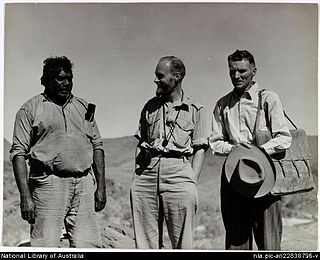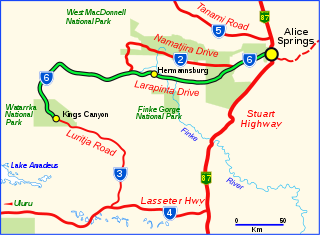The Hermannsburg School is an art movement, or art style, which began at the Hermannsburg Mission in the 1930s. The best known artist of the style is Albert Namatjira. The movement is characterised by watercolours of western-style landscapes that depict the often striking colours of the Australian outback.
Located 125 km west of Alice Springs, in Central Australia, Hermannsburg was founded by Lutheran missionaries in 1877. The Western Arrernte people have lived in this region for thousands of years. In 1941 Rex Battarbee founded the Aranda Art Group, which controlled the supply of materials and helped handle the business affairs of the emerging artists.™
The Hermannsburg painters' work is characterised by soft hues, usually water colours, of their Western Arrernte landscape, which European settlers named the Western Macdonnell Ranges. Previously, Western Arrernte people had only used art in a ceremonial sense, as topographical interpretations of their country and their particular Dreamings, painted using symbols.
Early works by Albert also conveyed this spiritual connection with the land. They shared an intimate knowledge of the land on which they had lived for thousands of years. The Ghost Gum features prominently in the works, a sacred and important part of Western Arrernte mythology. In the best works by Otto Pareroultja trees were painted as ancestral beings with body-like trunks & arm-like branches.
Albert Namatjira began his distinctive style after seeing an exhibition by travelling artists to the mission, Rex Battarbee and John Gardner, in the 1930s. Other artists from the Hermannsburg school include Wenten Rubuntja, Walter Ebatarinja, Otto Pareroultja, and his brothers Ruben and Edwin, as well as Albert's sons, Enos, Oscar, Ewald, Maurice and Keith, his grandson Gabriel, his son in law Claude Pannka as well as his granddaughter Gloria Pannka. Other members of the school include the brothers Henoch and Herbert Raberaba.
The Hermannsburg School represented a major change of direction for Australian aboriginal art. [1] The works produced by the movement were accessible to collectors who were more familiar with western-style landscapes. [1] It was also a successful economic model for aboriginal communities. [1] Today Hermannsburg is also well known for its potters, particularly its women.

Albert Namatjira was an Arrernte painter from the MacDonnell Ranges in Central Australia, widely considered one of the greatest and most influential Australian artists. As a pioneer of contemporary Indigenous Australian art, he was arguably one of the most famous Indigenous Australians of his generation. He was the first Aboriginal artist to receive popularity from a wide Australian audience.

Indigenous Australian art includes art made by Aboriginal Australian and Torres Strait Islander peoples, including collaborations with others. It includes works in a wide range of media including painting on leaves, bark painting, wood carving, rock carving, watercolour painting, sculpting, ceremonial clothing and sand painting; art by Indigenous Australians that pre-dates European colonisation by thousands of years, up to the present day.

Australian art is any art made in or about Australia, or by Australians overseas, from prehistoric times to the present. This includes Aboriginal, Colonial, Landscape, Atelier, early-twentieth-century painters, print makers, photographers, and sculptors influenced by European modernism, Contemporary art. The visual arts have a long history in Australia, with evidence of Aboriginal art dating back at least 30,000 years. Australia has produced many notable artists of both Western and Indigenous Australian schools, including the late-19th-century Heidelberg School plein air painters, the Antipodeans, the Central Australian Hermannsburg School watercolourists, the Western Desert Art Movement and coeval examples of well-known High modernism and Postmodern art.

Hermannsburg, also known as Ntaria, is an Aboriginal community in Ljirapinta Ward of the MacDonnell Shire in the Northern Territory of Australia, 125 kilometres (78 mi); west southwest of Alice Springs, on the Finke River, in the traditional lands of the Western Arrarnta people.
Kasper Gus Ntjalka Williams, known as Gus Williams, was an Aboriginal Australian country music singer who lived in Central Australia. He was known not only for his work in Aboriginal country music, but also as a leader of his people. He created the first electric country band in the Northern Territory, the Warrabri Country Bluegrass Band.
Ntaria Choir, formerly known as Ntaria Ladies Choir, Hermannsburg Ladies Choir, and various other names, is a choir of Australian Aboriginal people from Hermannsburg in Central Australia. The members of the choir are Arrernte people from the area and they sing a mixture of English and Arrente. They form part of the Central Australian Aboriginal Women's Choir (CAAWC).

Haasts Bluff, also known as Ikuntji, is an Aboriginal Australian community in Central Australia, a region of the Northern Territory. The community is located in the MacDonnell Shire local government area, 227 kilometres (141 mi) west of Alice Springs. At the 2006 census, the community, including outstations, had a population of 207.
Daisy Jugadai Napaltjarri was a Pintupi-Luritja-speaking Indigenous artist from Australia's Western Desert region, and sister of artist Molly Jugadai Napaltjarri. Daisy Jugadai lived and painted at Haasts Bluff, Northern Territory. There she played a significant role in the establishment of Ikuntji Women's Centre, where many artists of the region have worked.
Contemporary Indigenous Australian art is the modern art work produced by Indigenous Australians, that is, Aboriginal Australians and Torres Strait Islander people. It is generally regarded as beginning in 1971 with a painting movement that started at Papunya, northwest of Alice Springs, Northern Territory, involving Aboriginal artists such as Clifford Possum Tjapaltjarri and Kaapa Tjampitjinpa, and facilitated by white Australian teacher and art worker Geoffrey Bardon. The movement spawned widespread interest across rural and remote Aboriginal Australia in creating art, while contemporary Indigenous art of a different nature also emerged in urban centres; together they have become central to Australian art. Indigenous art centres have fostered the emergence of the contemporary art movement, and as of 2010 were estimated to represent over 5000 artists, mostly in Australia's north and west.

Reginald Ernest Battarbee was an Australian artist notable for painting landscapes of Central Australia, and for teaching Aboriginal artist Albert Namatjira to paint.
Namatjira the Painter is a 1947 documentary about the artist, Albert Namatjira. It deals with his background, his relationship with Rex Battarbee and how he learned to paint.

Larapinta Drive is a designated state route in the Northern Territory of Australia.
The Namatjira Project is an Australian community cultural development project, launched in 2009, conducted by arts and social change company Big hART. It is based in the Aboriginal communities of Hermannsburg (NT) and Alice Springs in the Northern Territory of Australia. Its focus is the life and work of the late Albert Namatjira, an Arrernte watercolour landscape artist. The project undertakes community work and has developed an award-winning touring theatre show, Namatjira, which depicts "the commercial appropriation of Aboriginal experience".
Vincent Namatjira is an Aboriginal Australian artist living in Indulkana, in the Anangu Pitjantjatjara Yankunytjatjara in South Australia. He has won many art awards, and after being nominated for the Archibald Prize several times, he became the first Aboriginal person to win it in 2020. He is the great-grandson of the Arrente watercolour artist Albert Namatjira.
The Hermannsburg Potters are a group of Aranda women who formed an arts centre in Hermannsburg, Northern Territory (Ntaria) who work with painted ceramics that draw on many influences, while strongly reflect the distinctive visual Aboriginal culture of Central Australia.
Friedrich Wilhelm Albrecht was a Lutheran missionary and pastor who was the superintendent at Hermannsburg Mission in Central Australia from 1926 - 1952 where he made a significant contribution.

Australian modernism, similar to European and American modernism, was a social, political and cultural movement that was a reaction to rampant industrialisation, associated moral panic of modernity and the death and trauma of the World Wars.
Therese Ryder is an Eastern Arrernte artist from Ltyentye Apurte Community, 82 km south east of Alice Springs. Ryder, part of the Iltja Ntjarra Many Hands Art Centre, is primarily a landscape artist and paints her traditional lands in the Central Desert. Ryder is also a linguist who significantly contributed to the "Central and Eastern Arrernte Dictionary" (1994) and also authored a book "Ayeye thipe-akerte: Arrernte stories about birds" (2017).
Iltja Ntjarra Many Hands Art Centre, or Many Hands Art Centre, is an Aboriginal owned and directed art centre based in Alice Springs and it is home to, and has a special focus on supporting, the Hermannsburg School; the best known artist of which was Albert Namatjira. It was established in 2004 by the Ngurratjuta/Pmara Ntjarra Aboriginal Coprporation as a place for Arrernte artists to come together to "paint, share and learn new techniques". The centre is also strongly committed to improving the economic participation of its artists, ethical work practices and returning the greatest possible percentage of sales to the artist.
Winnie Bamara was the first Indigenous Australian woman artist to paint in a European realist style. Her ability to paint scenes accurately and solely from memory attracted wide attention in the 1950s. She was hailed as a "female Albert Namatjira".
This article needs additional citations for verification .(March 2010) |